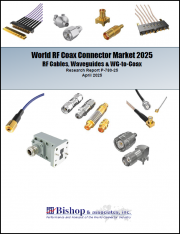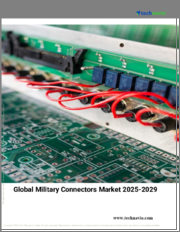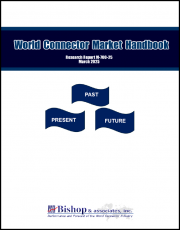
|
시장보고서
상품코드
1573984
세계의 커넥터 시장 : 제품 유형별, 최종 이용 산업별, 용도별, 재료별 - 예측(2025-2030년)Connector Market by Product Type (Automotive Connectors, Board-To-Board Connectors, Circular Connectors), End-Use Industry (Aerospace & Defense, Automotive, Consumer Electronics), Application, Material - Global Forecast 2025-2030 |
||||||
커넥터 시장의 2023년 시장 규모는 823억 7,000만 달러로 평가되었고, 2024년에는 887억 3,000만 달러로 추정되며, CAGR 6.44%로 성장할 전망이고, 2030년에는 1,275억 3,000만 달러에 도달할 것으로 예측됩니다.
커넥터 시장의 범위는 다른 회로를 결합하고 전기 신호 및 전력 전송을 용이하게 하는 장치의 개발과 공급입니다. 복잡한 시스템에서 원활한 전기적 연결을 보장할 필요가 있기 때문에 자동차, 통신, 항공우주, 일렉트로닉스 등 다양한 산업에서 필수적인 존재가 되고 있습니다. 용도는 데이터센터, 가전, 의료기기, 산업기계 등 다양합니다. 최종 용도는 고속 데이터 전송, 디바이스의 소형화, 접속 기능의 강화에 중점을 둔 분야에 이릅니다. 시장 성장에는 기술 발전, 웨어러블 디바이스 수요 증가, IoT 보급 및 통신 인프라 확대가 크게 영향을 받고 있습니다. 또한 전기자동차 및 스마트 그리드 기술로의 전환은 커넥터 제조업체에 잠재적인 비즈니스 기회를 제공합니다. 신흥국 시장과 신흥 경제 국가들은 또한 도시화와 산업화를 배경으로 확대를 위한 비옥한 토양을 제공합니다. 그러나 이 시장은 높은 원재료비, 엄격한 규제기준, 급속히 진화하는 기술에의 적응 등의 과제에 직면하고 있습니다. 또한, 가혹한 환경 조건 하에서 커넥터의 내구성과 신뢰성을 확보하는 것은 지속적인 과제가 되고 있습니다. 이러한 장애물에도 불구하고 경량 합금 및 전도성 폴리머의 사용과 같은 재료 혁신은 유망한 연구 분야를 제공합니다. 예지 보전과 스마트 커넥티비티를 위해 AI와 머신러닝을 도입함으로써 비즈니스 성장을 더욱 촉진할 수 있습니다. 시장은 소형화와 고속 데이터 전송의 실현에 동향하고 있으며, 지속적인 연구개발 투자가 필요합니다. 그럼에도 불구하고, 이러한 영역에서 비즈니스 기회를 극대화하려는 기업의 경우, 선진 분야의 역동적 인 요구에 부응하는 적응성이 높고 비용 효율적인 솔루션을 창출하는 데 주력하는 것이 매우 중요합니다. 특히 지속가능성과 에너지 효율에 중점을 두어야 합니다.
| 주요 시장 통계 | |
|---|---|
| 기준년(2023년) | 823억 7,000만 달러 |
| 예측년(2024년) | 887억 3,000만 달러 |
| 예측년(2030년) | 1,275억 3,000만 달러 |
| CAGR(%) | 6.44% |
시장 역학 : 빠르게 진화하는 커넥터 시장의 주요 시장 인사이트 공개
커넥터 시장은 수요 및 공급의 역동적 인 상호 작용에 의해 변모하고 있습니다. 이러한 시장 역학의 진화를 이해함으로써 기업은 충분한 정보를 바탕으로 투자결정, 전략적 결정 정밀화, 새로운 비즈니스 기회 획득에 대비할 수 있습니다. 이러한 동향을 종합적으로 파악함으로써 기업은 정치적, 지리적, 기술적, 사회적, 경제적 영역에 걸친 다양한 리스크를 경감할 수 있을 뿐만 아니라, 소비자 행동과 그것이 제조 비용 또는 구매 동향에 미치는 영향을 보다 명확하게 이해할 수 있습니다.
- 시장 성장 촉진요인
- 고속 데이터 트랜스미션 수요가 증가함에 따라 고급 커넥터의 필요성 증가
- 전기자동차의 채용 증가에 의해 견고한 커넥터 솔루션의 개발 필요
- 통신 인프라에 대한 투자 증가로 신뢰성이 높은 커넥터에 대한 수요 증가
- 산업 자동화의 기술 진보가 커넥터 설계의 혁신에 박차
- 시장 성장 억제요인
- 고급 커넥터 기술에 따른 높은 제조 비용
- 커넥터의 생산과 유통에 영향을 주는 엄격한 규제 기준
- 시장 기회
- 지속적인 성장을 위한 세계 커넥터 시장의 미래 동향과 혁신 분석
- 신기술에 특화된 커넥터 솔루션에서의 틈새 비즈니스 기회 탐구
- 첨단 커넥터 기술에 의한 디지털 전환과 스마트 매뉴팩처링에 있어서 시장 가능성의 평가
- 시장의 과제
- 기술 혁신을 촉진하고 커넥터 제조업체의 이익률을 저하시키는 경쟁의 격화
- 커넥터 업계에서의 생산 라이프 사이클의 단축과 개발 비용의 상승으로 이어지는 급속한 기술 진보
Porter's Five Forces : 커넥터 시장을 탐색하는 전략 도구
Porter's Five Forces 프레임 워크는 커넥터 시장 경쟁 구도를 이해하는 중요한 도구입니다. Porter's Five Forces 프레임 워크는 기업의 경쟁력을 평가하고 전략적 기회를 탐구하는 명확한 기술을 제공합니다. 이 프레임 워크는 기업이 시장 내 세력도를 평가하고 신규 사업의 수익성을 판단하는 데 도움이 됩니다. 이러한 인사이트를 통해 기업은 자사의 강점을 활용하고, 약점을 해결하고, 잠재적인 과제를 피할 수 있으며, 보다 강인한 시장에서의 포지셔닝을 보장할 수 있습니다.
PESTLE 분석 : 커넥터 시장의 외부 영향 파악
외부 거시적 환경 요인은 커넥터 시장의 성과 역학을 형성하는데 매우 중요한 역할을 합니다. 정치적, 경제적, 사회적, 기술적, 법적, 환경적 요인 분석은 이러한 영향을 탐색하는 데 필요한 정보를 제공합니다. PESTLE 요인을 조사함으로써 기업은 잠재적인 위험과 기회를 더 잘 이해할 수 있습니다. 이 분석을 통해 기업은 규제, 소비자 선호, 경제 동향의 변화를 예측하고 앞으로 예상되는 적극적인 의사 결정을 할 준비를 할 수 있습니다.
시장 점유율 분석 : 커넥터 시장에서 경쟁 구도 파악
커넥터 시장의 상세한 시장 점유율 분석을 통해 공급업체의 성과를 종합적으로 평가할 수 있습니다. 기업은 수익, 고객 기반, 성장률 등 주요 지표를 비교하여 경쟁 포지셔닝을 밝힐 수 있습니다. 이 분석을 통해 시장 집중, 단편화, 통합 동향을 밝혀내고 벤더들은 경쟁이 치열해지는 가운데 자사의 지위를 높이는 전략적 의사 결정을 내리는 데 필요한 지식을 얻을 수 있습니다.
FPNV 포지셔닝 매트릭스 : 커넥터 시장에서 공급업체의 성능 평가
FPNV 포지셔닝 매트릭스는 커넥터 시장에서 공급업체를 평가하는 중요한 도구입니다. 이 행렬을 통해 비즈니스 조직은 공급업체의 비즈니스 전략과 제품 만족도를 기준으로 평가하여 목표에 맞는 충분한 정보를 바탕으로 의사 결정을 내릴 수 있습니다. 네 가지 사분면을 통해 공급업체를 명확하고 정확하게 부문화하고 전략 목표에 가장 적합한 파트너 및 솔루션을 파악할 수 있습니다.
전략 분석 및 추천 : 커넥터 시장에서 성공에 대한 길을 그립니다.
커넥터 시장의 전략 분석은 세계 시장에서의 존재를 강화하려는 기업에게 필수적입니다. 주요 자원, 역량 및 성과 지표를 검토함으로써 기업은 성장 기회를 파악하고 개선을 위해 노력할 수 있습니다. 이러한 접근 방식을 통해 경쟁 구도에서 과제를 극복하고 새로운 비즈니스 기회를 활용하여 장기적인 성공을 거둘 수 있는 체제를 구축할 수 있습니다.
이 보고서는 주요 관심 분야를 포괄하는 시장의 종합적인 분석을 제공합니다.
1. 시장 침투 : 현재 시장 환경의 상세한 검토, 주요 기업의 광범위한 데이터, 시장 도달범위 및 전반적인 영향력을 평가합니다.
2. 시장 개척도 : 신흥 시장의 성장 기회를 파악하고 기존 분야의 확장 가능성을 평가하며 미래 성장을 위한 전략적 로드맵을 제공합니다.
3. 시장 다양화 : 최근 제품 출시, 미개척 지역, 업계의 주요 진보, 시장을 형성하는 전략적 투자를 분석합니다.
4. 경쟁 평가 및 정보 : 경쟁 구도를 철저히 분석하여 시장 점유율, 사업 전략, 제품 포트폴리오, 인증, 규제 당국 승인, 특허 동향, 주요 기업의 기술 진보 등을 검증합니다.
5. 제품 개발 및 혁신 : 미래 시장 성장을 가속할 것으로 예상되는 최첨단 기술, 연구개발 활동, 제품 혁신을 강조합니다.
또한 이해관계자가 충분한 정보를 얻고 의사결정을 할 수 있도록 중요한 질문에 대답하고 있습니다.
1. 현재 시장 규모 및 향후 성장 예측은?
2. 최고의 투자 기회를 제공하는 제품, 부문 및 지역은 어디입니까?
3. 시장을 형성하는 주요 기술 동향 및 규제의 영향은?
4. 주요 벤더의 시장 점유율 및 경쟁 포지션은?
5. 벤더 시장 진입 및 철수 전략의 원동력이 되는 수익원과 전략적 기회는 무엇인가?
목차
제1장 서문
제2장 조사 방법
제3장 주요 요약
제4장 시장 개요
제5장 시장 인사이트
- 시장 역학
- 성장 촉진요인
- 고속 데이터 트랜스미션 수요가 증가함에 따라 고급 커넥터의 필요성 증가
- 전기자동차의 보급 확대에는 견고한 커넥터 솔루션의 개발 필요
- 통신 인프라 투자 증가로 신뢰성 높은 커넥터 수요 증가
- 산업 자동화의 기술 진보가 커넥터 디자인의 혁신 촉진
- 억제요인
- 고급 커넥터 기술과 관련된 높은 제조 비용
- 커넥터의 생산과 유통에 영향을 주는 엄격한 규제 기준
- 기회
- 지속적인 성장을 위한 세계 커넥터 시장의 미래 동향 및 혁신 분석
- 신기술에 특화된 커넥터 솔루션에 있어서의 틈새 시장 탐구
- 첨단 커넥터 기술에 의한 디지털 전환과 스마트 제조 시장 잠재력 평가
- 과제
- 격렬한 경쟁에 의해 혁신이 촉진되어 커넥터 제조업체의 이익률 감소
- 급속한 기술 발전으로 커넥터 업계에서는 생산 수명주기가 단축되고 개발 비용 증가
- 성장 촉진요인
- 시장 세분화 분석
- Porter's Five Forces 분석
- PESTEL 분석
- 정치적
- 경제
- 사교
- 기술적
- 법률상
- 환경
제6장 커넥터 시장 : 제품 유형별
- 자동차용 커넥터
- 와이어 대 기판 커넥터
- 전선 대 전선 커넥터
- 기판 대 기판 커넥터
- 백플레인
- 카드 엣지
- 플렉서블 프린트 회로(FPC)
- 원형 커넥터
- 푸시풀 커넥터
- RF 커넥터
- I/O 커넥터
- HDMI 커넥터
- 네트워크 커넥터
- USB 커넥터
- 직사각형 커넥터
- 카드 엣지 커넥터
- 헤더와 리셉터클
- 파워 엔트리 모듈
제7장 커넥터 시장 : 최종 이용 산업별
- 항공우주 및 방위
- 항공
- 군
- 자동차
- 상용차
- 승용차
- 가전
- 가전제품
- 개인용 디바이스
- 산업
- 자동화
- 제조업
- 통신
- 데이터센터
- 모바일 네트워크
제8장 커넥터 시장 : 용도별
- 데이터 연결
- 무선 LAN
- 원
- 동력 변속기
- 저전압
- RF 연결
- 휴대
- 위성
제9장 커넥터 시장 : 소재별
- 금속
- 알루미늄
- 구리
- 강철
- 플라스틱
- 열가소성
- 열경화성 플라스틱
제10장 아메리카의 커넥터 시장
- 아르헨티나
- 브라질
- 캐나다
- 멕시코
- 미국
제11장 아시아태평양의 커넥터 시장
- 호주
- 중국
- 인도
- 인도네시아
- 일본
- 말레이시아
- 필리핀
- 싱가포르
- 한국
- 대만
- 태국
- 베트남
제12장 유럽, 중동 및 아프리카의 커넥터 시장
- 덴마크
- 이집트
- 핀란드
- 프랑스
- 독일
- 이스라엘
- 이탈리아
- 네덜란드
- 나이지리아
- 노르웨이
- 폴란드
- 카타르
- 러시아
- 사우디아라비아
- 남아프리카
- 스페인
- 스웨덴
- 스위스
- 터키
- 아랍에미리트(UAE)
- 영국
제13장 경쟁 구도
- 시장 점유율 분석(2023년)
- FPNV 포지셔닝 매트릭스(2023년)
- 경쟁 시나리오 분석
- 전략 분석 및 제안
The Connector Market was valued at USD 82.37 billion in 2023, expected to reach USD 88.73 billion in 2024, and is projected to grow at a CAGR of 6.44%, to USD 127.53 billion by 2030.
The scope of the connector market involves the development and supply of devices that join different circuits together, facilitating the transmission of electrical signals and power. They are indispensable in various industries such as automotive, telecommunications, aerospace, and electronics, owing to their necessity for ensuring seamless electrical connectivity in complex systems. The application range covers data centers, consumer electronics, medical devices, and industrial machinery, highlighting their versatile utility. End-use extends to sectors focused on high-speed data transfer, miniaturization of devices, and enhanced connectivity capabilities. The market's growth is significantly influenced by advancements in technology, increasing demand for wearable devices, the proliferation of IoT, and the expansion of telecommunications infrastructure. Moreover, the shift towards electric vehicles and smart grid technology presents potential opportunities for connector manufacturers. Emerging markets and developing economies also offer a fertile ground for expansion, driven by urbanization and industrialization. However, the market faces limitations such as high raw material costs, stringent regulatory standards, and the challenging adaptation to rapidly evolving technology. Additionally, ensuring the durability and reliability of connectors in extreme environmental conditions poses a continual challenge. Despite these hurdles, innovation in materials, like using lightweight alloys and conductive polymers, offers promising areas for research. Incorporating AI and machine learning for predictive maintenance and smart connectivity can further drive business growth. The market is trending towards miniaturization and achieving higher data rates, necessitating continual R&D investment. Nevertheless, for businesses looking to maximize their opportunities within this space, it is crucial to focus on creating adaptable and cost-effective solutions that cater to the dynamic needs of advanced sectors, particularly focusing on sustainability and energy efficiency.
| KEY MARKET STATISTICS | |
|---|---|
| Base Year [2023] | USD 82.37 billion |
| Estimated Year [2024] | USD 88.73 billion |
| Forecast Year [2030] | USD 127.53 billion |
| CAGR (%) | 6.44% |
Market Dynamics: Unveiling Key Market Insights in the Rapidly Evolving Connector Market
The Connector Market is undergoing transformative changes driven by a dynamic interplay of supply and demand factors. Understanding these evolving market dynamics prepares business organizations to make informed investment decisions, refine strategic decisions, and seize new opportunities. By gaining a comprehensive view of these trends, business organizations can mitigate various risks across political, geographic, technical, social, and economic domains while also gaining a clearer understanding of consumer behavior and its impact on manufacturing costs and purchasing trends.
- Market Drivers
- Growing demand for high-speed data transmission amplifies the need for advanced connectors
- Increasing adoption of electric vehicles necessitates development of robust connector solutions
- Rising investment in telecommunications infrastructure drives demand for reliable connectors
- Technological advancements in industrial automation spur innovation in connector designs
- Market Restraints
- High manufacturing costs associated with advanced connector technologies
- Stringent regulatory standards impacting the production and distribution of connectors
- Market Opportunities
- Analyzing future trends and innovations in the global connector market for sustainable growth
- Exploring niche opportunities in specialized connector solutions for emerging technologies
- Evaluating market potential in digital transformation and smart manufacturing with advanced connector technologies
- Market Challenges
- High competition driving innovation and reducing profit margins for connector manufacturers
- Rapid technological advancements leading to while reducing production lifecycles and increasing development costs in the connector industry
Porter's Five Forces: A Strategic Tool for Navigating the Connector Market
Porter's five forces framework is a critical tool for understanding the competitive landscape of the Connector Market. It offers business organizations with a clear methodology for evaluating their competitive positioning and exploring strategic opportunities. This framework helps businesses assess the power dynamics within the market and determine the profitability of new ventures. With these insights, business organizations can leverage their strengths, address weaknesses, and avoid potential challenges, ensuring a more resilient market positioning.
PESTLE Analysis: Navigating External Influences in the Connector Market
External macro-environmental factors play a pivotal role in shaping the performance dynamics of the Connector Market. Political, Economic, Social, Technological, Legal, and Environmental factors analysis provides the necessary information to navigate these influences. By examining PESTLE factors, businesses can better understand potential risks and opportunities. This analysis enables business organizations to anticipate changes in regulations, consumer preferences, and economic trends, ensuring they are prepared to make proactive, forward-thinking decisions.
Market Share Analysis: Understanding the Competitive Landscape in the Connector Market
A detailed market share analysis in the Connector Market provides a comprehensive assessment of vendors' performance. Companies can identify their competitive positioning by comparing key metrics, including revenue, customer base, and growth rates. This analysis highlights market concentration, fragmentation, and trends in consolidation, offering vendors the insights required to make strategic decisions that enhance their position in an increasingly competitive landscape.
FPNV Positioning Matrix: Evaluating Vendors' Performance in the Connector Market
The Forefront, Pathfinder, Niche, Vital (FPNV) Positioning Matrix is a critical tool for evaluating vendors within the Connector Market. This matrix enables business organizations to make well-informed decisions that align with their goals by assessing vendors based on their business strategy and product satisfaction. The four quadrants provide a clear and precise segmentation of vendors, helping users identify the right partners and solutions that best fit their strategic objectives.
Strategy Analysis & Recommendation: Charting a Path to Success in the Connector Market
A strategic analysis of the Connector Market is essential for businesses looking to strengthen their global market presence. By reviewing key resources, capabilities, and performance indicators, business organizations can identify growth opportunities and work toward improvement. This approach helps businesses navigate challenges in the competitive landscape and ensures they are well-positioned to capitalize on newer opportunities and drive long-term success.
Key Company Profiles
The report delves into recent significant developments in the Connector Market, highlighting leading vendors and their innovative profiles. These include Amphenol Corporation, Anderson Power Products, Bel Fuse Inc., Cinch Connectivity Solutions, Delphi Technologies, Fischer Connectors, Glenair, Hirose Electric Group, HUBER+SUHNER, ITT Cannon, JAE Electronics, Lemo, Molex, Phoenix Contact, Positronic Industries, Radiall, Rosenberger, Samtec, TE Connectivity, and Yazaki Corporation.
Market Segmentation & Coverage
This research report categorizes the Connector Market to forecast the revenues and analyze trends in each of the following sub-markets:
- Based on Product Type, market is studied across Automotive Connectors, Board-To-Board Connectors, Circular Connectors, I/O Connectors, and Rectangular Connectors. The Automotive Connectors is further studied across Wire-To-Board Connectors and Wire-To-Wire Connectors. The Board-To-Board Connectors is further studied across Backplane, Card Edge, and Flexible Printed Circuits (FPC). The Circular Connectors is further studied across Push-Pull Connectors and RF Connectors. The I/O Connectors is further studied across HDMI Connectors, Network Connectors, and USB Connectors. The Rectangular Connectors is further studied across Card Edge Connectors, Headers And Receptacles, and Power Entry Modules.
- Based on End-Use Industry, market is studied across Aerospace & Defense, Automotive, Consumer Electronics, Industrial, and Telecommunications. The Aerospace & Defense is further studied across Aviation and Military. The Automotive is further studied across Commercial Vehicle and Passenger Vehicle. The Consumer Electronics is further studied across Home Appliances and Personal Devices. The Industrial is further studied across Automation and Manufacturing. The Telecommunications is further studied across Data Centers and Mobile Networks.
- Based on Application, market is studied across Data Connectivity, Power Transmission, and RF Connectivity. The Data Connectivity is further studied across LAN and WAN. The Power Transmission is further studied across Low-Voltage. The RF Connectivity is further studied across Mobile and Satellite.
- Based on Material, market is studied across Metal and Plastic. The Metal is further studied across Aluminum, Copper, and Steel. The Plastic is further studied across Thermoplastic and Thermosetting Plastic.
- Based on Region, market is studied across Americas, Asia-Pacific, and Europe, Middle East & Africa. The Americas is further studied across Argentina, Brazil, Canada, Mexico, and United States. The United States is further studied across California, Florida, Illinois, New York, Ohio, Pennsylvania, and Texas. The Asia-Pacific is further studied across Australia, China, India, Indonesia, Japan, Malaysia, Philippines, Singapore, South Korea, Taiwan, Thailand, and Vietnam. The Europe, Middle East & Africa is further studied across Denmark, Egypt, Finland, France, Germany, Israel, Italy, Netherlands, Nigeria, Norway, Poland, Qatar, Russia, Saudi Arabia, South Africa, Spain, Sweden, Switzerland, Turkey, United Arab Emirates, and United Kingdom.
The report offers a comprehensive analysis of the market, covering key focus areas:
1. Market Penetration: A detailed review of the current market environment, including extensive data from top industry players, evaluating their market reach and overall influence.
2. Market Development: Identifies growth opportunities in emerging markets and assesses expansion potential in established sectors, providing a strategic roadmap for future growth.
3. Market Diversification: Analyzes recent product launches, untapped geographic regions, major industry advancements, and strategic investments reshaping the market.
4. Competitive Assessment & Intelligence: Provides a thorough analysis of the competitive landscape, examining market share, business strategies, product portfolios, certifications, regulatory approvals, patent trends, and technological advancements of key players.
5. Product Development & Innovation: Highlights cutting-edge technologies, R&D activities, and product innovations expected to drive future market growth.
The report also answers critical questions to aid stakeholders in making informed decisions:
1. What is the current market size, and what is the forecasted growth?
2. Which products, segments, and regions offer the best investment opportunities?
3. What are the key technology trends and regulatory influences shaping the market?
4. How do leading vendors rank in terms of market share and competitive positioning?
5. What revenue sources and strategic opportunities drive vendors' market entry or exit strategies?
Table of Contents
1. Preface
- 1.1. Objectives of the Study
- 1.2. Market Segmentation & Coverage
- 1.3. Years Considered for the Study
- 1.4. Currency & Pricing
- 1.5. Language
- 1.6. Stakeholders
2. Research Methodology
- 2.1. Define: Research Objective
- 2.2. Determine: Research Design
- 2.3. Prepare: Research Instrument
- 2.4. Collect: Data Source
- 2.5. Analyze: Data Interpretation
- 2.6. Formulate: Data Verification
- 2.7. Publish: Research Report
- 2.8. Repeat: Report Update
3. Executive Summary
4. Market Overview
5. Market Insights
- 5.1. Market Dynamics
- 5.1.1. Drivers
- 5.1.1.1. Growing demand for high-speed data transmission amplifies the need for advanced connectors
- 5.1.1.2. Increasing adoption of electric vehicles necessitates development of robust connector solutions
- 5.1.1.3. Rising investment in telecommunications infrastructure drives demand for reliable connectors
- 5.1.1.4. Technological advancements in industrial automation spur innovation in connector designs
- 5.1.2. Restraints
- 5.1.2.1. High manufacturing costs associated with advanced connector technologies
- 5.1.2.2. Stringent regulatory standards impacting the production and distribution of connectors
- 5.1.3. Opportunities
- 5.1.3.1. Analyzing future trends and innovations in the global connector market for sustainable growth
- 5.1.3.2. Exploring niche opportunities in specialized connector solutions for emerging technologies
- 5.1.3.3. Evaluating market potential in digital transformation and smart manufacturing with advanced connector technologies
- 5.1.4. Challenges
- 5.1.4.1. High competition driving innovation and reducing profit margins for connector manufacturers
- 5.1.4.2. Rapid technological advancements leading to while reducing production lifecycles and increasing development costs in the connector industry
- 5.1.1. Drivers
- 5.2. Market Segmentation Analysis
- 5.3. Porter's Five Forces Analysis
- 5.3.1. Threat of New Entrants
- 5.3.2. Threat of Substitutes
- 5.3.3. Bargaining Power of Customers
- 5.3.4. Bargaining Power of Suppliers
- 5.3.5. Industry Rivalry
- 5.4. PESTLE Analysis
- 5.4.1. Political
- 5.4.2. Economic
- 5.4.3. Social
- 5.4.4. Technological
- 5.4.5. Legal
- 5.4.6. Environmental
6. Connector Market, by Product Type
- 6.1. Introduction
- 6.2. Automotive Connectors
- 6.2.1. Wire-To-Board Connectors
- 6.2.2. Wire-To-Wire Connectors
- 6.3. Board-To-Board Connectors
- 6.3.1. Backplane
- 6.3.2. Card Edge
- 6.3.3. Flexible Printed Circuits (FPC)
- 6.4. Circular Connectors
- 6.4.1. Push-Pull Connectors
- 6.4.2. RF Connectors
- 6.5. I/O Connectors
- 6.5.1. HDMI Connectors
- 6.5.2. Network Connectors
- 6.5.3. USB Connectors
- 6.6. Rectangular Connectors
- 6.6.1. Card Edge Connectors
- 6.6.2. Headers And Receptacles
- 6.6.3. Power Entry Modules
7. Connector Market, by End-Use Industry
- 7.1. Introduction
- 7.2. Aerospace & Defense
- 7.2.1. Aviation
- 7.2.2. Military
- 7.3. Automotive
- 7.3.1. Commercial Vehicle
- 7.3.2. Passenger Vehicle
- 7.4. Consumer Electronics
- 7.4.1. Home Appliances
- 7.4.2. Personal Devices
- 7.5. Industrial
- 7.5.1. Automation
- 7.5.2. Manufacturing
- 7.6. Telecommunications
- 7.6.1. Data Centers
- 7.6.2. Mobile Networks
8. Connector Market, by Application
- 8.1. Introduction
- 8.2. Data Connectivity
- 8.2.1. LAN
- 8.2.2. WAN
- 8.3. Power Transmission
- 8.3.1. Low-Voltage
- 8.4. RF Connectivity
- 8.4.1. Mobile
- 8.4.2. Satellite
9. Connector Market, by Material
- 9.1. Introduction
- 9.2. Metal
- 9.2.1. Aluminum
- 9.2.2. Copper
- 9.2.3. Steel
- 9.3. Plastic
- 9.3.1. Thermoplastic
- 9.3.2. Thermosetting Plastic
10. Americas Connector Market
- 10.1. Introduction
- 10.2. Argentina
- 10.3. Brazil
- 10.4. Canada
- 10.5. Mexico
- 10.6. United States
11. Asia-Pacific Connector Market
- 11.1. Introduction
- 11.2. Australia
- 11.3. China
- 11.4. India
- 11.5. Indonesia
- 11.6. Japan
- 11.7. Malaysia
- 11.8. Philippines
- 11.9. Singapore
- 11.10. South Korea
- 11.11. Taiwan
- 11.12. Thailand
- 11.13. Vietnam
12. Europe, Middle East & Africa Connector Market
- 12.1. Introduction
- 12.2. Denmark
- 12.3. Egypt
- 12.4. Finland
- 12.5. France
- 12.6. Germany
- 12.7. Israel
- 12.8. Italy
- 12.9. Netherlands
- 12.10. Nigeria
- 12.11. Norway
- 12.12. Poland
- 12.13. Qatar
- 12.14. Russia
- 12.15. Saudi Arabia
- 12.16. South Africa
- 12.17. Spain
- 12.18. Sweden
- 12.19. Switzerland
- 12.20. Turkey
- 12.21. United Arab Emirates
- 12.22. United Kingdom
13. Competitive Landscape
- 13.1. Market Share Analysis, 2023
- 13.2. FPNV Positioning Matrix, 2023
- 13.3. Competitive Scenario Analysis
- 13.4. Strategy Analysis & Recommendation
Companies Mentioned
- 1. Amphenol Corporation
- 2. Anderson Power Products
- 3. Bel Fuse Inc.
- 4. Cinch Connectivity Solutions
- 5. Delphi Technologies
- 6. Fischer Connectors
- 7. Glenair
- 8. Hirose Electric Group
- 9. HUBER+SUHNER
- 10. ITT Cannon
- 11. JAE Electronics
- 12. Lemo
- 13. Molex
- 14. Phoenix Contact
- 15. Positronic Industries
- 16. Radiall
- 17. Rosenberger
- 18. Samtec
- 19. TE Connectivity
- 20. Yazaki Corporation



















